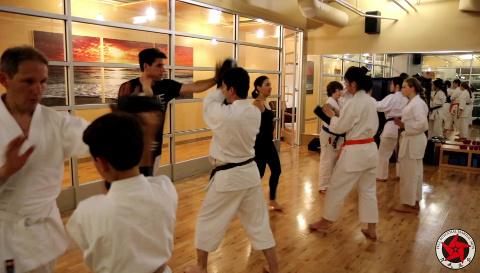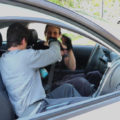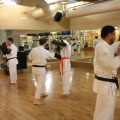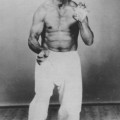Developing the ability to hit hard, reliably, and in a variety of situations, is a key practical karate skill. Being able to generate good power and hit hard is very useful in self-defense as well as in combative sports.
Simply said, the only way to learn to hit hard is to practice it. Therefore, impact training should be a key component in any practical karate program. “Air punching,” as is typically used during basics/kihon in most karate programs is invaluable in learning proper movement pattern and precision. However, air punching/kicking, etc. alone will not teach martial arts power generation.
There are many excellent impact training aids that we can use in out impact training. They include the makiwara (traditional karate striking post), boxing heavy bag, focus mitts, Thai pads and others. For a discussion of the benefits of different martial arts impact training equipment see this article.
The video below shows 4-step progression program for developing hard hitting power. Detailed explanations follow.

Step 1: Hit Stationary Targets
As good place to start is in developing our ability to hit hard against stationary targets. Focus on proper body dynamics – namely, hitting with your entire body and not just the limb. (This is a deep topic, see this article on power generation in karate and martial arts for a start.) Key step 1 components:
- Use proper body dynamics
- Practice a variety of techniques & combinations
- Utilize different aids, such as makiwara, heavy-bags, focus mitts and Thai pads
One of the common mistakes karate practitioners make when hitting is to get in a stance and then hit. This results in all the momentum of the movement stopping, rather than manifesting in the strike. A better way to think about stances is as transition points. For maximum power, the entire body should be in motion as we are making contact. As my students frequently hear me say (usually in a voice imitation of the fictional Sensei Miyagi from Karate Kid):
“Hit with whole body.”
The makiwara can be an indispensable aid in this step.
Step 2: Hit Moving Targets
Once we can hit stationary targets with precision and with good power, we can transition to hitting moving targets. Our goal is to be able to hit, with precision and with good power. Thai Pads with a skilled partner/holder are indispensable at this phase!
We can start cooperatively, and then move on to the partner moving uncooperatively, while we are trying to land strikes. A few key points:
- Start slow, and focus on proper body dynamics
- Work on maintaining your targeting precision!
- Practice a variety of techniques & combinations
Step 3: Learn to hit from Disadvantageous Positions
Disadvantageous positions are challenging because they do not allow you to use the full body motion we trained in steps 1 and 2.
Still, in many cases we may find ourselves in a disadvantageous, non-ideal position. This is especially true in self defense. We may be seated, on the ground, with our back to a wall or corner, or learning forward. Key points in learning to generate power from a non-ideal position are the following:
- Disadvantageous positions encumber movement
- Continue to employ proper power generation: use your large muscles and core and not just the limb; hit with your entire body; generate rotation torque; generate spinal whip; take advantage of gravity
- Practice different positions
The goal is to get to a point where you can hit hard regardless of the situation.
Step 4: Incorporate impact training in your Live Drills / Sparring
Of course, when we train with a partner we have to keep them safe. Full power impact training is not appropriate to be practiced on a partner. Still, we can incorporate full power impact training by alternating between partner live drills/sparring, and heavy impact work. Again, Thai pads are very useful.
Closing Comments
Developing the ability to hit hard, reliably, and in a variety of situations, is a key practical karate skill, and is invaluable in physical self-defense and in full contact combative sports. The 4-step training program above will help develop your striking power. Spend adequate time in each step, and remember that you can always improve by going back to basics and hitting stationary targets.






I loved what you said about starting slow and focusing on proper body dynamics when doing karate. I’d really like to start learning karate this summer as a form of exercise. I’m hoping that I can reach out to a few different dojos to see which offer adult classes.
This has been very informative. Karate is one of the most popular types of martial arts and it might be challenging to develop the skills needed. But with proper training, it is possible. How long do you recommend practicing every day?
I truly agree that for a hit to have a strong impact, one should practice daily and observe the correct form or stance as much as possible to avoid injury and hit the target. Karate training, or any other martial arts, may be dragging, especially for kids or beginners, but you will see changes in your lifestyle and even develop self-discipline. After all, karate is good self-defense.